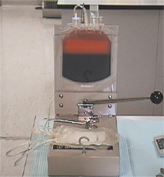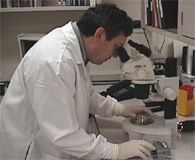Blood
Stem Cell Program For Transplantation
|
| Cord
blood is an alternative source of stem cells used for
re-population of the patient�s bone marrow after chemotherapy
or radiation therapy. Research has led to the discovery
that the blood in a baby's umbilical cord is rich in stem
cells. These cord blood stem cells can be collected immediately
after the baby's birth, processed and stored for use by
the baby, a matched sibling, or an HLA-matched unrelated
patient. |
�
Cord
Blood Collection
 |
Cord
blood is collected in small (250 ml) blood collection
bags containing anticoagulant to prevent blood
from clotting. This bag also allows the collected
blood to be processed in a close system. This
technique limits the possibility of bacterial
contamination during extensive blood processing. |
|
�
Two
Ways to Collect Cord Blood
|
|
In-utero
collection: After the baby is delivered, cord blood
collection can be initiated when the placenta is still
in-utero. This technique usually gives a little bit
higher volume recovery then ex-utero collection.
Ex-utero
collection: After the baby is delivered and the
placenta detaches from the utero, the placenta and cord
are carefully handled and placed in a provided collection
system. Both techniques are painless and do not affect
the baby�s health.
|
�
Delivery
of the Cord Blood to the Blood Center
 |
Bergen
Community Regional Blood Center operates 24 hours
a day. The collection facility informs the Blood
Bank about cord blood collection. Collected units
are picked up from the delivery site by a Blood
Bank employee or designated courier. |
|
�
Processing
of Cord Blood
 |
Processing
of cord blood is performed as soon as possible
but no later than 48 hours after collection.
Processing involves three major steps:
1.
Removal of red cells
2.
Volume reduction of White Cell Concentrate
3.
Freezing
|
|
�
Cord
Blood and Maternal Blood Testing
|
| Each
sample of maternal blood matching collected cord blood
is tested against the panel of recommended tests. Positive
results of these tests may disqualify the cord blood from
being used in the future. |
 |
 |
 |
�
Storage
 |
Cord
Blood units are stored in a Liquid Nitrogen
Freezer.�To guarantee safety of the stored units:
- The
storage facility is equipped with an electrical
power generator.
- Each
freezer has its own battery back-up.
- Temperatures
are:
- Recorded
around the clock
- Monitored
by an independent company
- Checked
daily and recorded by an employee of the
Blood Center
- Liquid
Nitrogen feeding of the freezers is controlled
automatically and carefully monitored.
|
|
 �
�  �
�